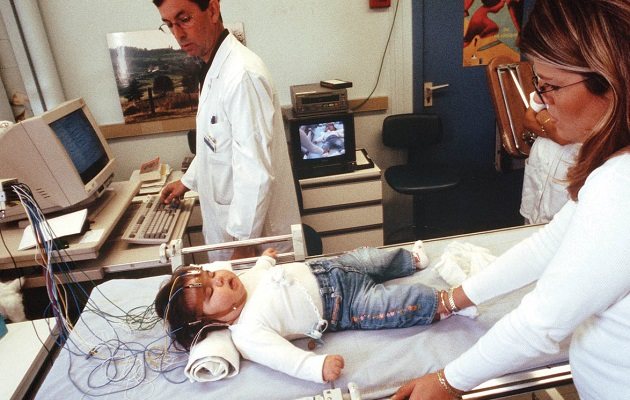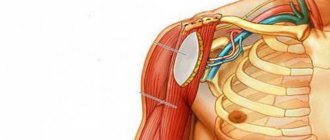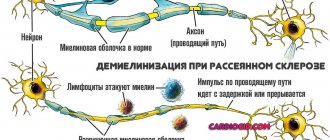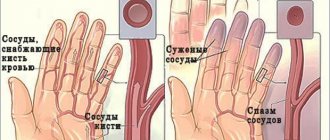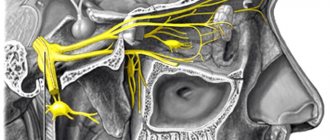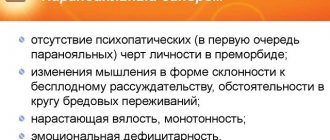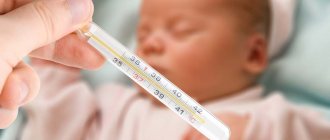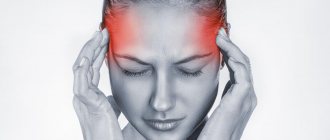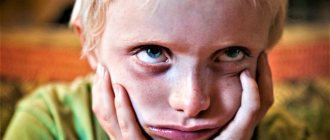Epilepsy in infants
The brain is one of the most complex organs in the human body, characterized by the accumulation of a large number of neurons. Epilepsy in newborns is diagnosed if they are in constant tension. For temporary containment, an unexpected breakthrough occurs, which negatively affects all structural elements of the brain. During an attack, the newborn experiences a short-term loss of consciousness. The clinical picture is aggravated by spontaneous muscle contraction. In some young patients, defecation or urine production is provoked at this moment.
Main causes of the disease
In this matter, genetic predisposition to the disease is not in the first place. In medical practice, the following signs of epilepsy in infants are distinguished:
- Infection of the fetus inside the womb. Most often, cytomegalovirus acts as a negative factor.
- Periodic occurrence of the syndrome in chromosomal units.
- During childbirth, the central nervous system was injured.
- Improper fetal development.
- The child received an injury to the skull area.
- Tumors or other neoplasms.
The nature of the manifestation of the disease in infancy
After birth, parents should closely monitor the baby. They try to identify unusual aspects of his behavior. In this case, the external stimulus in this situation cannot be detected.
Seizures at an early age occur due to insufficient readiness of the brain to function fully. All processes of inhibition or metabolism have not yet fully developed in it. To make a correct diagnosis, you will need to analyze the characteristics of seizures. Most often they develop against the background of fever.
Simple seizures in children have the following features:
- The duration does not exceed 15 minutes.
- Seizures occur extremely rarely.
- During attacks, the limbs stretch and twitch slightly. This situation is aggravated by loss of consciousness.
In infants, complex seizures also have a number of features:
- Lasts more than 15 minutes.
- Not even a day passes between attacks.
- During an attack, the child's eyes look up or to the side.
- Twitching may be observed in only one limb.
Symptoms of epilepsy most often go away without medical intervention for up to six years. Only in 5% of children do they end in full-blown epilepsy.
This clinical picture is characteristic of febrile seizures. Only a neurologist or pediatrician can correctly recognize them. Epilepsy is suspected in any child who has had at least one episode of seizures. They also occur against the background of fever.
A newborn may experience a random seizure due to the negative impact of the following external and internal factors:
- Poisoning by substances or individual components.
- An electric current was applied to the body.
- Impact of sun or heat.
- Hypoglycemia, which develops against the background of diabetes mellitus.
In children under one year of age, epilepsy is diagnosed based on the following symptoms:
- A certain period of manifestation.
- The absence of obvious external or internal factors that could provoke the situation.
Today, an epleptologist is involved in diagnosing this disease. He prescribes all the necessary tests that will allow you to correctly diagnose and make a prognosis.
Home diagnostics
The health care provider should obtain objective information from relatives about the nature and extent of certain symptoms. If possible, you need to record the following data:
- When was the first attack?
- Duration of the cramp in minutes?
- During an attack, each child exhibits certain characteristics. For example, it can spread to one of the limbs and be characterized by a special position of the head, legs or arms. Some children remain conscious.
- There are a number of factors that are classified as provoking factors. Among them, stress, poor sleep or bright light occupy a special place.
- It is also important to observe the child’s behavior after the attack ends. Equally important is his excitement, sleep or excessive anxiety.
- At what time of day do convulsions occur most often?
Epilepsy in children most often manifests itself between the ages of 2 and 14 years. In this case, the first attack should occur no earlier than ten years. Additionally, the children show no signs of brain dysfunction. Not all young patients had this pathology previously recorded in their immediate family history.
Symptoms can only appear exclusively in the facial area. In this case, the baby experiences tonic contractions of the cheeks and tongue. The limbs are involved in the process in severe degrees of the disease.
At the first stage of the development of epilepsy, the child only exhibits an unusual posture during sleep. During this period, certain parts of his body are under great tension. Additionally, you may notice a slight distortion of the position of the oral cavity. After awakening, such children can still remain for a long time without obvious signs of consciousness.
In 1-year-old children, an attack can last more than 15 minutes. Periodically they may regain consciousness. The condition is dangerous because it can lead to swelling of the brain. If a child experiences such an attack, he must be hospitalized immediately.
What does an attack look like and its types?
Epilepsy attacks in children may not even be noticeable to others. They manifest themselves as small twitches of the face or its parts, short-term disorientation. The child cannot be distracted by anything. This is a non-convulsive generalized type of seizure. It lasts only a few seconds, after which the baby returns to what he was doing earlier.
A generalized seizure is characterized by tension in the muscles of the body, slight cessation of breathing, convulsions with possible involuntary urination, loss of consciousness or sleep. Atonic, on the other hand, looks like ordinary fainting.
Infantile spasm as a type of epileptic seizure is possible almost from birth. These are involuntary tilts of the head forward (nods). Such attacks pass with age or develop into a more severe form.
Features of diagnostics
After the first attack, the baby must undergo an electroencephalogram. Patients receive this prescription if there are no additional external triggers for seizures. Thanks to research in the future, it will be possible to reduce the likelihood of developing the disease to a minimum. Based on the results, a further course of treatment is selected. To obtain a more informative picture, a diagnosis should be made during paroxysm. Parents can be absolutely calm about their baby, because the study cannot worsen his health and is completely painless.
Breastfeeding involves the use of a study with video monitoring. He records the attack and records its EEG. Thanks to him, it is possible to study the nature of the pathology in more detail before performing an MRI. If we compare the method with CT, we can note its complete safety. However, MRI can only be started after the drug has been administered to the infant. At this age, it is impossible to immobilize the baby in any other way.
What to do during an attack?
If a child has a tendency to epilepsy, then parents should learn in advance methods to alleviate his condition:
- If before the onset of the attack there were other negative manifestations, then the baby must be urgently placed on a flat surface with his back down. His throat should not be constricted by buttons or collar.
- It is best if there are no objects nearby that could harm the baby. Additionally, it is also recommended to remove it away from water.
- The relative should not panic. It is important to take complete control of the situation. The body must be securely fixed until the end of the attack.
- You need to tilt your head to the side. This will prevent tongue retraction and saliva aspiration. The same position should be when vomiting.
- Foreign objects should not be placed in the mouth.
- Anticonvulsants will help ease your general well-being. Only a doctor can choose them correctly.
- After the attack ends, the child should rest or sleep.
- Parents should monitor the baby's body temperature.
- The drugs are administered rectally. This method is considered the safest.
Features of treatment of the disease
If the required course of therapy is not completed on time, the risk of the child’s developmental delay increases. Anticonvulsant medications work to prevent future relapses. Spontaneous seizures pose a great danger to the child’s life.
Treatment methods that are actively used to eliminate epilepsy:
- Taking one anti-convulsant drug.
- Therapy begins with taking a minimum dose.
- If one drug does not cope with the functions assigned to it, then it is supplemented with a second one.
- Treatment of epilepsy is based on an individual approach to each patient.
- The pills must be taken according to a special schedule.
- The course of treatment is at least three years.
- The intensity of treatment can be reviewed by the attending physician depending on the individual reaction of the body.
The consequences of epilepsy directly depend on the nature and intensity of symptoms. At one time, there is practically no negative effect on the brain. Only prolonged paroxysms are dangerous. They lead to the death of nerve cells in large numbers.
There is also a negative connotation socially. For example, a child may have a seizure in any public place. Against this background, his risk of being embarrassed in front of friends or classmates increases. Such babies often withdraw into themselves and prefer to lead a solitary lifestyle. Convulsions that occur with loss of consciousness pose a high degree of danger. They can even lead to death and therefore require proper treatment.
Possible consequences and complications
Timely treatment of epilepsy in infancy will help avoid its manifestations in adulthood. 75% of children are successfully treated and by the age of 12 they no longer experience any symptoms of the disease.
Depending on the form of the disease, its course, the increase or complete attenuation of symptoms, older children can go to specialized institutions under the supervision of specialists or to a regular kindergarten and school.
However, complications that arise after attacks can be quite dangerous:
- Injuries to the arms and legs caused by seizures.
- Disorders of mental development and difficulties in mastering speech.
- Deterioration of mental state.
- Transition of the disease from a childhood form to an older one.
- The appearance of status epilepticus (a series of seizures lasting about 30 minutes).
- Death of the patient due to injury or respiratory arrest.
For infants whose symptoms of epilepsy have appeared once, preventive measures should be carried out regularly. Hiking, visiting forests and parks will be useful. You can engage in outdoor games and swimming accompanied by adults.
Cause-and-effect relationship or why does a child develop a disease?
Parents of children with epilepsy are concerned about why the disease befell the child and what are the causes of the pathology.
Factors that cause the appearance of epilepsy:
- Failure in the formation of the brain during fetal development. Provoking reasons: during the period of bearing a child, abuse of alcohol and drugs, smoking. The likelihood of developing epilepsy increases if a woman has had a cold, flu, or herpes during pregnancy.
- Age of the expectant mother. The older a woman is, the greater the risk of having a baby with developmental disabilities increases.
- Features of the prenatal process and childbirth, which leads to damage to the already formed brain. This often occurs: during long labor, a long stay of the baby without amniotic fluid, if the child is entwined with the umbilical cord, special forceps are used for delivery.
- Epilepsy can be caused by disorders of the nervous system. Frequent diseases of a bacterial and cold nature, which were accompanied by high temperatures and convulsions.
- Concussion due to a fall or injury to brain cells.
- Idiopathic causes of infertility mean that the disease is inherited. Low levels of dopamine are responsible for inhibiting chemical processes in the brain.
- Lack of vitamins and microelements. Back in 1973, American scientists, based on research results, identified a connection between seizures and mineral deficiency. Parents should monitor the level of zinc and magnesium in the child’s body. Magnesium quickly decreases when stressful situations arise, temperature rises, and physical activity increases.
- Any brain tumor, benign or malignant, can cause the development of the disease.
- Cryptogenic causes in which it is impossible to determine what caused epilepsy.
Living with epilepsy
Epilepsy in children and its prognosis worries many parents. As for the life and adaptation of the baby, the behavior, reaction and support of the parents play a significant role here. Teaching children with epilepsy is possible, but there are some nuances. A visit to a regular kindergarten is possible if the child has infrequent and controlled seizures, and also if the kindergarten has not refused to accept your baby. But even in this case, an alternative to specialized child care institutions is possible.
The teacher and health worker must be informed about the presence of this disease in the child, the characteristics of the attacks, and the use of medications. His training should be subject to requirements that are common to all, unless, of course, his psyche has been damaged as a result of the disease.
Sport plays an important role in a child’s life. If proper treatment is carried out and there are no attacks, the child can engage in almost all sports. The exceptions are exercises on sports equipment, equestrianism and mountaineering. The baby can swim only under supervision. If attacks are frequent, then sports should be replaced with long walks and activities at home with parents.
A conversation with a child about his illness should take place in a friendly manner and, preferably, without strangers. He must know that they will always come to his aid.
Epilepsy attacks in infants and their symptoms
Signs of epilepsy in infants are significantly different from seizures that occur in adults. Symptoms of epilepsy in newborns are quite difficult to recognize, since they are similar to the baby’s normal motor activity. This feature makes diagnosis difficult.

The disease has the following symptoms:
- Seizures are the seizures most often associated with epilepsy. When a seizure occurs, all the muscles of the body tense, and the baby’s breathing stops for a short period of time. After this, convulsions begin, which can have varying intensity and duration. Spontaneous emptying of the bladder. After some time, the convulsions stop, the child calms down and falls asleep.
- Seizures without convulsions are common presentations in infants. The child suddenly freezes, his gaze becomes absent. There is a slight twitching of the eyelids, the baby throws his head back and closes his eyes. All attempts to attract his attention come to nothing. These manifestations are short-term, no more than 20 seconds. After the attack, the child returns to his usual activities. Parents rarely notice them.
- An atonic attack is characterized by loss of consciousness and relaxation of all muscles. From the outside it looks like fainting. If your child frequently loses consciousness for no reason, you should consult a doctor.
- A spasm, when it occurs, the arms are involuntarily pulled to the chest, the head is tilted, and the legs are straightened. Often this phenomenon occurs after the child wakes up.
Risk factors and groups
Not every child can experience epilepsy.
There are a number of factors that increase the risk of epilepsy from infancy:
- convulsions;
- epileptiform activity on the electroencephalogram;
- score within 0-3 on the Apgar scale;
- severe prematurity, less than 31 weeks;
- resuscitation at birth;
- family predisposition to epilepsy;
- infections suffered while in the womb, such as herpetic encephalitis;
- mental difficulties;
- restrictions of movement or paralysis of limbs with cerebral palsy.
"Major" epilepsy
It is also called “true”.
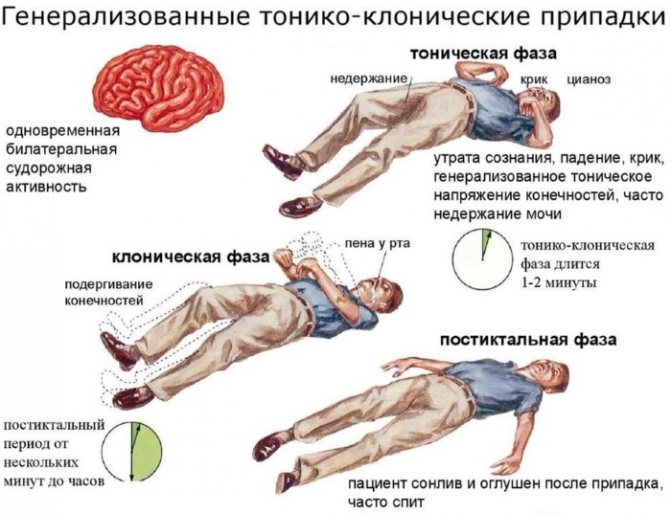
This type of epilepsy is accompanied by various types of seizures:
- tonic - individual muscle groups straighten and become immobile;
- clonic - some muscles begin to constantly contract;
- mixed - one type of seizure is replaced by another.
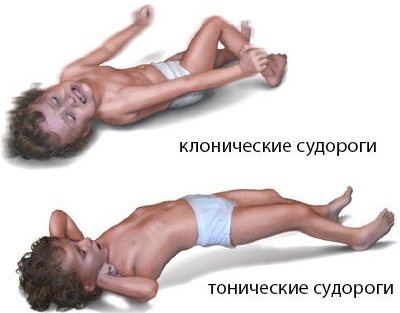
Also, with “major” epilepsy, the child may experience accompanying unpleasant conditions:
- dizziness, up to loss of consciousness;
- involuntary release of urine and saliva;
- short-term cessation of breathing;
- biting the tongue with bloody foam coming from the mouth.
"Minor" epilepsy
This type of disease is characteristic exclusively of childhood. Its peculiarity is that only certain muscle groups come into an excited state.
Manifestations of “minor” epilepsy:
- turning the child's head to one side;
- unblinking gaze;
- staying motionless in one position;
- one of the muscle groups either suddenly tenses or suddenly relaxes;
- Abdominal cramps and subsequent vomiting are less common;
- increased heart rate;
- increased body temperature;
- increased sweating.
Nocturnal epilepsy
This type of pathology is activated during sleep, which indicates the presence of its focus in the frontal lobes of the brain. Traditionally, nocturnal epilepsy is considered one of the mild forms that can be treated with medication. True, you need to undergo a long course of therapy under the supervision of specialists.
Features of nocturnal epilepsy:
- a seizure may occur before waking up;
- trembling of the legs when falling asleep and dysfunction of the limbs upon awakening;
- restless sleep;
- presence of signs of sleepwalking (talking or walking in your sleep).
In the absence or suspension of treatment, complications such as waking up in a bad mood or self-harm are possible.
Temporal lobe epilepsy
It is characterized by a more severe course over time, as well as the presence of prolonged attacks.
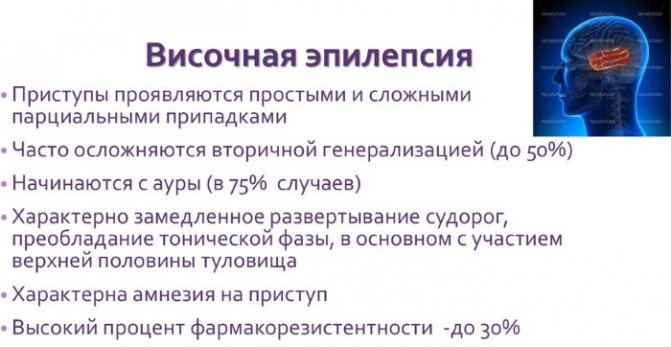
Convulsions are preceded by:
- active heartbeat;
- impaired swallowing reflex;
- pain in the abdominal area;
- vomiting;
- difficulty breathing;
- increased sweating.
Specific signs of epilepsy are simple and complex seizures.
Simple attacks include:
- the appearance of an anxious mood;
- loss of orientation in space;
- movement of the head and eyes in the direction of the source of the disease.
Complex seizures involve repeated movements:
- swallowing;
- smacking;
- chewing;
- unnatural giggles;
- pronouncing the same sound;
- blinking;
- pat;
- scratching.
Diagnosis of epilepsy in newborns
Epilepsy can be recognized by determining the child’s condition, as well as by observing general symptoms. Suspicion of epilepsy arises when seizures are detected for no apparent reason.
If a child has a seizure, he needs immediate medical attention. The doctor who can diagnose epilepsy is a neurologist.
Stages of diagnosing the disease:
- Collecting information to compile a medical history. Includes a survey of the mother about the course of pregnancy and the condition of the baby after birth. Having relatives with a similar disease. Illnesses and injuries of the child.
- A story about a child's seizure, taking into account the smallest details.
- Medical examination, which consists of assessing cardiac, neurological and mental status.
- Donate blood for analysis to exclude the presence of other diseases.
- Computed tomography, which allows you to determine the nature of the attack.
- Carrying out an electroencephalogram.
- Magnetic resonance imaging, which allows you to assess the state of the brain and identify pathologies.
After conducting the above studies and analyzing the results, the doctor determines whether there is epilepsy or not.
Establishing diagnosis
Diagnosis of this disease is a complex process. Very often children have seizures that are in no way related to this disease. Seizures, early in the course of the disease, manifest as classic generalized seizures and atypical seizures. Much later they acquire a generalized appearance.
The onset of the disease can occur unnoticed for both the baby and the parents. For example, sleepwalking, agitation. If a pronounced attack occurs, parents should immediately consult a doctor.
To confirm the diagnosis, it is necessary to undergo electroencephalography, as well as computed tomography or magnetic resonance imaging. With the help of these studies, it is possible to identify the focus of brain damage and speak for sure about the diagnosis.
How to treat epilepsy in children, a chance for a healthy lifestyle
After carrying out diagnostic measures and making the correct diagnosis, the neurologist prescribes treatment.

Epilepsy: stage one
First of all, the baby needs rest and a proper daily routine. Parents must protect their child from stress and shock. Avoid strong tantrums. The mother needs to be nearby all the time so that the baby feels calm and balanced.
Stage two
Nutrition adjustments. Breastfed babies are calmer and have an emotional connection with their mother. It is important for a woman during the lactation period to adhere to a strict diet.
Avoid fried, salted, pickled and smoked foods. Establish a drinking regime and take vitamins.
For bottle-fed babies, it is recommended to select the most suitable and approved formulas together with your pediatrician.
Stage three
Taking anticonvulsants. They are prescribed by a doctor, taking into account the diagnosis, the age of the baby and the individual characteristics of the body.
Initially, the minimum dosage of the drug is indicated, followed by its increase. Sometimes immunotherapy and hormonal treatment are required.
Principles of treatment
Many parents wonder about the need to treat this disease. Any specialist will tell you with confidence that it is important and needs to be treated. The duration of treatment and its direction can only be determined by a specialist after a complete examination of your baby.
Currently, individually selected anticonvulsants are used, which are highly effective and have minimal side effects for your child.
The drug must be appropriate for the type of attack and given in a sufficient dose. As a rule, treatment is started with small doses, then the effectiveness of the drug is looked at. If it is suitable, then the dose is gradually increased, and the same drug is used for no more than three years. If the treatment is not effective, then the specialist selects another method of therapy.
Treatment of epilepsy is carried out to eliminate the cause of seizures and reduce them. Without treatment, they will not disappear, and over time, the child’s condition will worsen. Irreversible consequences, such as disability, are possible. A very important principle of treatment is adherence to the regimen and diet therapy. It is recommended to limit fluids, consume less spicy and salty foods, alcoholic beverages and strong tea or coffee. Prevention of epilepsy in children pursues the same goals.
What should parents do during a child’s seizure: first aid
For a minor attack, there is no need for special measures. If the attack is severe and accompanied by seizures, parents should do everything possible to prevent the child from getting hurt.
First aid consists of doing the following:
- Hold the baby's body and head.
- Remove tight clothing.
- Give access to oxygen by opening the window.
- If breathing stops, perform artificial ventilation.
- Stays nearby all the time.
- Give the medicine only after the child has regained consciousness.
It is necessary to call an ambulance if such an attack occurs for the first time, if the seizure lasts more than 5 minutes. If convulsions recur after a short period of time.
After an attack of epilepsy, children fall asleep deeply. It is important to monitor the child at this time, as the seizure syndrome may recur. 2 hours of continuous sleep means that the attack is over.
Negative effects of epilepsy on child development
Most parents are frightened by the diagnosis of epilepsy. It is important to remember that the disease is not always inherited. It does not affect the psyche, so the child is not at risk of aggression or mental retardation.
Parents are inclined to think that potent drugs have side effects. In fact, the lack of treatment for a disease causes more harm than the influence of drugs.
Nowadays, epilepsy has been well studied, and effective methods have been developed to combat it. The disease is no longer an obstacle to normal life.
Why is epilepsy scary?
The consequences of epilepsy in children can vary. First of all, your child may face misunderstanding from peers. They can make fun of him and make fun of him in every possible way. The psychological component of this issue is very important. Parents should explain to the child that this disease does not make him worse than others, he is just a little different. It is important to teach him to recognize the onset of an attack, to tell him about the correct daily routine, what he can do and what he cannot do. If necessary, you need to talk to your classmates.
The baby will not be able to fully engage in physical activity, participate in active games, or visit the pool, since the exacerbation is spontaneous.
From a physiological point of view, after prolonged attacks, damage to brain cells, as well as nerve cells, is possible, which leads to their death.
You should be wary of surprise, as the baby can be seriously injured. He cannot be left alone for long. There were accidents, bruises, and fractures.
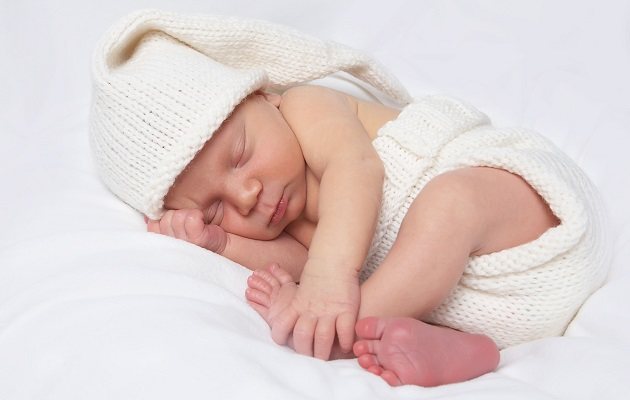
Epilepsy in newborns
Epilepsy is a chronic neurological disease, which is characterized by constant excitation at the site of accumulation of neurons. Due to a periodically bursting electrical impulse from the focus of the accumulation of nerve cells, all structural elements of the brain are excited. It is at this moment that an epileptic attack occurs, in which the child experiences convulsions, involuntary urination or defecation, and loss of consciousness.
Epilepsy is diagnosed in children much more often than in adults. The first symptoms of the disease may appear within a month after birth. When the first signs appear, you should immediately consult a doctor. A competent approach to the treatment of epilepsy ensures complete relief from this disease.
Diagnosis and treatment of epileptic seizures are carried out at the Yusupov Hospital, equipped with the latest equipment. This guarantees high accuracy of examination results and effectiveness of therapy. Neurologists and epileptologists of the clinic provide professional assistance to patients with epilepsy over 18 years of age.

Epilepsy during pregnancy
Should you think about pregnancy and planning a child? - important questions for an expectant mother suffering from epilepsy. The presence of the disease does not exclude the possibility of having a healthy and healthy baby. It is not at all necessary that it will be inherited. But the expectant mother must prepare in advance for this important period.
It is necessary to choose a specialist and consult about possible risks and consequences. If pregnancy occurs unexpectedly, it is better to consult a doctor as soon as possible, since taking medications can have a detrimental effect on the health of the unborn baby. Pregnancy and childbirth do not affect the course of the disease in any way, and it may even improve. An epileptologist will help you choose the required dose of the drug during pregnancy or replace the drug with another one, if necessary.
The probability of giving birth to a healthy toddler is 90%. If parents are worried about the health of the future baby, then there is a large number of studies that allow a woman to find out about certain abnormalities in the early stages.
Taking antiepileptic drugs does not affect breastfeeding in any way. A very small amount of the drug passes into the milk. Therefore, the child can receive nutritious nutrition with virtually no risk.
Epilepsy is a serious disease that, however, can be treated. If you consult a doctor in time and undergo high-quality examination and treatment, the causes of epileptic seizures can be eliminated or their number reduced.
Symptoms of epilepsy in infants
Epileptic seizures are recorded in children almost three times more often than in adults. This disease has certain characteristics that are typical for infants. Identifying such symptoms in children under one year of age is a rather difficult task, because they can be perceived as the baby’s normal physical activity.
Many people believe that seizures must occur with epilepsy. However, practice proves that epileptic seizures can be varied and not in all cases convulsive seizures are observed. Epilepsy is a group of clinical diseases that includes more than sixty different pathologies. Due to such diversity, diagnosing epilepsy is difficult. The disease may manifest itself with the following symptoms:
- absence seizures – muscle contractions without convulsions. The occurrence of such attacks may go unnoticed. During them, the baby throws his head back, looks at one point, remains indifferent throughout the entire attack, and his gaze is empty. After the attack has passed, the baby, as a rule, continues the interrupted game;
- convulsive contractions - at the beginning of the attack, muscle tension and interruptions in the functioning of the respiratory system are noted. The duration of convulsions is, as a rule, 10-20 seconds, after which, due to excessive fatigue, the baby may fall asleep;
- atonic seizures - the child completely loses consciousness, all his muscles relax;
- nightmares – the child’s sleep is disturbed, he may scream in his sleep, there are signs of sleepwalking;
- increased body temperature;
- headaches - against the background of pain, the baby experiences nausea and vomiting;
- speech impairment - despite the normal development of the speech apparatus, during attacks the child has difficulty reproducing words.
Some diseases have similar symptoms, so diagnosing an epileptic seizure at such an early age is quite difficult. If there is the slightest suspicion of epilepsy, parents should immediately contact a neurologist. According to statistics, early access to qualified medical care for epilepsy in children guarantees better treatment results.
Yusupov Hospital offers accurate diagnosis and effective treatment of epilepsy, taking into account the individual characteristics of each patient. The clinic is equipped with the most modern diagnostic equipment, ensuring maximum reliability of research results.
Types and forms of epilepsy
Epilepsy in infants, the symptoms of which depend on the form of the disease, can have several manifestations. It is worth considering the most popular of them.
Dravet syndrome
Severe pathology leading to difficulties in psychomotor development and sometimes death. Appears at 2-10 months. Features: multiple attacks during the day.
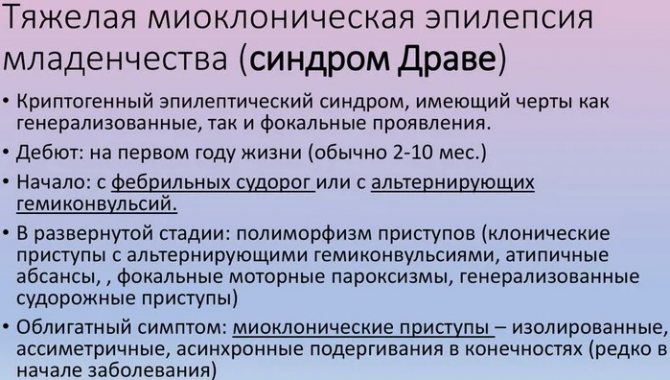
This condition can last for several days in a row (up to a week). Then a short break - 2-3 weeks, and everything repeats again. Convulsions may be present or everything can be done with muscle twitching and disturbances of consciousness.
Benign myoclonus epilepsy of infancy
Appears before the age of 3 years (early manifestations occur at 4-11 months). The disease is not preceded by psychomotor impairment. It is considered an idiopathic or symptomatic form of the disease and is milder than Dravet syndrome. Characteristic signs are short-term myoclinic (wobbly legs) attacks involving the head and arms.
Doose syndrome
Occurs in children aged 1-5 years. The disease is characterized by short-term convulsions, up to several times a minute, and nodding movements are common. Consciousness does not suffer in this case.
Epileptic seizures in this case are associated with diseases of the central nervous system, motor dysfunction, and mental retardation.
Benign familial seizures
Observed from the age of 3 days. Their appearance is associated with the presence of epileptic seizures in family members of the newborn. The attacks do not last long - 1-2 minutes, but their number can reach up to 30 per day. 1-3 weeks after the onset of seizures disappear.
Benign nonfamilial seizures
Observed on the 5th day after birth. Accompanied by muscle contractions in the limbs and on the face, sometimes on the right, sometimes on the left. Repeat throughout the day. Completely disappear after 2 weeks.
Ohtahara syndrome
A rare malignant disease. Appears in the first months of life. It is characterized by tonic attacks in the amount of 10-300 per day. The child has serious anomalies in the formation of the central nervous system.
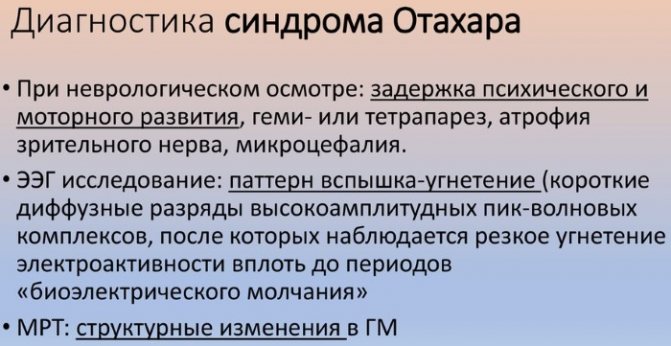
With age, the risk of mortality increases (up to 40-50%).
West syndrome
Catastrophic epilepsy, which becomes noticeable between the ages of 3 and 8 months. Accompanied by flexion and extension movements. It can develop with or without problems with the central nervous system. The consequences are delayed development of psychomotor functions, the appearance of signs of cerebral palsy. The prognosis of the disease is unfavorable.
Idiopathic benign partial epilepsies
Their collective name is “Watanabe syndrome”. They make themselves felt at the age of 3-20 months. They are characterized by complex partial seizures, moderate convulsions, cessation of motor activity, and bluish discoloration of the skin.
Early epileptic encephalopathy
Registered in the neonatal period of development. Characterized by a high degree of lethality. The genetic factor plays a significant role in the occurrence of the disease. Accompanied by myoclonic seizures, often fragmentary, but gaining intensity with age. Focal seizures, the center of occurrence of which is in the brain, are fundamental to the disease.
Vitamin B6 dependent epilepsy
The disease, which is inherited, may appear after 1 month of life. This is typical for children whose mothers took pyridoxine during pregnancy. Children remain restless between attacks and react to external irritants with muscle contractions.
The disease is not treated with conventional anticonvulsants and subsides when taking large doses of vitamin B6 (25 mg/kg per day).
Malignant wandering partial seizures
A very rare disease, only 50 cases are known in the world. Half of them occurred in the first days of life, the other half at the age of 1-3 months. It begins with the manifestation of one (focal) focus of seizures, and then turns into a multifocal (multifocal) form.

The disease demonstrates drug resistance and does not create metabolic problems.
Causes of epilepsy in newborns
With the development of an epileptic seizure, chaotic waves of brain activity are noted, which acquire a sharp character. The clinical picture of the attack is similar to a convulsion of a certain duration.
The occurrence of epilepsy in children under one year of age can be due to a number of reasons:
- if during pregnancy the expectant mother drank alcohol, used drugs, or suffered from serious colds;
- if labor occurred with complications: asphyxia, umbilical cord entanglement, intrauterine infections, prolonged anhydrousness, etc.;
- after serious illnesses suffered by a baby under one year of age: meningitis, encephalitis and others, as well as after traumatic brain injuries received during childbirth or in infancy;
- in the presence of a genetic predisposition;
- with a deficiency of microelements in the child’s body. Recent studies have proven the connection between zinc and magnesium deficiency and the development of epilepsy in children;
- due to cryptogenic (unexplained) reasons.
The main task of epileptologists at the Yusupov Hospital is to timely and reliably establish a diagnosis and determine the specific form of epilepsy, which will help select the most optimal treatment tactics and improve the prognosis.
Cramps - what are they?
It is important to note that there are many reasons why they can occur. For example, in some children after vaccination, it is quite possible for them to appear as a complication. A large number of babies under one year old suffer from seizures at very high temperatures. This is not a diagnosis yet, but children prone to such attacks should be monitored by their attending physician, as the symptoms may worsen. Disability due to epilepsy in children is not uncommon.
In some cases, there was a transition to epilepsy after febrile seizures. If the baby has a history of brain injury, he may also have seizures, and not necessarily epileptic ones. Sunstroke, hypoglycemia, poisoning—all this can cause isolated attacks.
